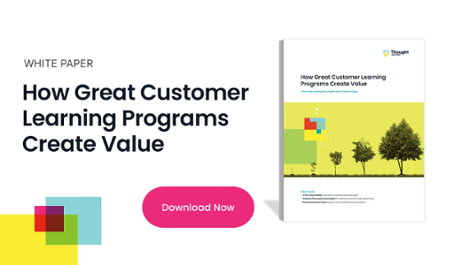Our CEO Barry Kelly recently sat down with David Wentworth, Principal Learning Analyst, Brandon Hall Group to discuss the benefits of extending training to the external ecosystem of customers and partners. They covered a wide range of data on the challenges that exist today in measuring the impact of customer training, as well as covering how you can start strong with a data-led approach in your external training programs. Let’s dive into the discussion!
The Benefits of Customer Training
Customer training is a fast-growing market, accelerated by the COVID-19 pandemic. In fact, 77% of people said that customer education has increased in importance since the pandemic began. Necessity is the mother of invention, but the need for remote training is far from the only benefit. 65% of people believe that external training to the market is the route to improving customer relationships, while 45% have seen training improve retention. For 43%, customer training itself already generates revenue for the organization, and allows learning and development to move from being a traditional cost center, to a revenue generator instead.
With these benefits in mind, there is a responsibility on today’s organizations to provide customer education, and through that, to make sure that individuals are trained, informed and enlightened on how they can use the organization’s product to achieve success.
However, 65% of respondents are currently struggling to measure the impact of their customer education programs, and 40% believe they don’t have the right technology. These two challenges are inextricably linked.
Choosing the Right Technology for Customer Education
Just 16% of people believe that technology has a low impact on the effectiveness of their training. Barry and David have both seen many companies that start out trying to create a customer training solution with a traditional LMS or on their website, and who have come unstuck. It’s really important to have a clear vision of what you want to achieve. When making the change to the right technology, David likes to ask customers, “What is your current technology not doing, or what is it doing poorly?” This provides a focus, rather than starting from square one.
Generally, home-grown solutions will make it harder to measure the impact of your customer education, as they just don’t have the data or analytics capabilities. Companies often don’t think about measuring impact, and so they build a solution before realizing they’re not in a good place to analyze the results. As a result, the top three routes to measuring effectiveness are feedback surveys (53%), assessments (50%), and completion rates (43%). This information really only tells the organization if their customers enjoyed the training, or if they understood the information that they were given. It does nothing to tell you whether you’re any closer to achieving organizational goals such as deflecting support, increasing product adoption, onboarding more users, or improving retention. In fact, only 6% of organizations have these kinds of predetermined KPIs in the first place, despite these metrics being the best way to understand if training is working.
This is at heart a technology problem. In order to measure against organizational goals, your technology needs to be external facing, and allow you to glean insight from support platforms, customer success teams, NPS and gross retention rates, product engagement, and more. You need to be able to do this for trained and untrained customers, and compare the differences. This is ultimately how you will know whether your training is making a difference.
The Technology Must-Haves For Monetizing Education Content
When it comes to monetization, your technology choice will either support you in creating revenue from your customer education, or act as a blocker. There are a few checkboxes to look for when choosing an LMS that allows you to monetize your content at scale as well as measure its impact. These include alignment to sales and marketing teams, a deep integration with commerce, and the ability to deploy in a customized way.
Of course, charging for training is not always the right move, so it’s important to make sure direct revenues is the correct strategy for this content. If you’re looking to monetize, Barry suggests you start by charging a la carte for a specific course or piece of content, then move on to create bundles, wider courses, or subscription models.
For this to work, and to support monetization needs such as coupons, discounts, regional customers and different currencies and taxes, above all you need an eCommerce integration that’s deep within your LMS. This is something that just 26% of companies can say that they have, with 51% admitting that they don’t have eCommerce functionality at all.
Collecting and Using Data Effectively
Altogether, there are three stages to creating a data-driven strategy for customer training. First, decide what you’re measuring, including aligning with corporate goals and KPIs such as revenue, retention or support deflection. No two companies measure their operations exactly the same way, and even a single organization will evolve over time. It’s important to be very clear about your objectives. Are you a rapid growth company? Are you at the early stages, or more mature? Are you looking to build a new profit center? Make sure your educational programs are pointing directly at that goal, whatever it might be.
Next, look at where you can access the data that you need. Traditional LMS tools won’t report on external information like financial or customer success data, and they tend to be focused on engagement instead of learner outcomes. There will be data repositories across the business that are essential, in departments like sales, support, operations and product. Find out where they are, and how to get access to that data.
Last, it’s time to compile all that information and take action from it. A Business Intelligence tool can help you to consolidate your information from varying sources, and access a holistic picture of the impact of your customer education, including any insights and trends.
Don’t Leave Untapped Value on the Table
The potential for extending training to your wider ecosystem is huge, with both customer relationships and direct revenue on the table. However, this will remain untapped if organizations continue to struggle to adequately measure the effectiveness of their education. Once you’ve established goals for your organization, the right technology is a critical element of success, allowing you to accurately measure the impact of your education, and to develop a monetization strategy to efficiently and effectively generate revenues.

There’s so much to cover from this data-driven discussion, we can’t possibly fit it all into one sitting! Check out the whole webinar for the full conversation, including:
- How to use customer education to improve customer experience and reduce costs.
- The benefits of multiple modalities, and the most common content in use today.
- Deciding whether to monetize; how can you recognize when it works to charge?


